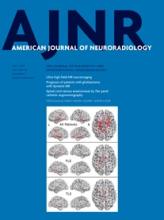Review ArticleReview Articles
Open Access
Mechanisms of Healing in Coiled Intracranial Aneurysms: A Review of the Literature
W. Brinjikji, D.F. Kallmes and R. Kadirvel
American Journal of Neuroradiology July 2015, 36 (7) 1216-1222; DOI: https://doi.org/10.3174/ajnr.A4175
W. Brinjikji
aFrom the Department of Radiology, Mayo Clinic, Rochester, Minnesota.
D.F. Kallmes
aFrom the Department of Radiology, Mayo Clinic, Rochester, Minnesota.
R. Kadirvel
aFrom the Department of Radiology, Mayo Clinic, Rochester, Minnesota.

Submit a Response to This Article
Jump to comment:
No eLetters have been published for this article.
In this issue
American Journal of Neuroradiology
Vol. 36, Issue 7
1 Jul 2015
Advertisement
W. Brinjikji, D.F. Kallmes, R. Kadirvel
Mechanisms of Healing in Coiled Intracranial Aneurysms: A Review of the Literature
American Journal of Neuroradiology Jul 2015, 36 (7) 1216-1222; DOI: 10.3174/ajnr.A4175
Jump to section
Related Articles
Cited By...
- Impact of Smoking on Recurrence and Angiographic Outcomes after Endovascular Treatment of Intracranial Aneurysms: A Systematic Review and Meta-analysis
- Hydrogel Coils versus Bare Platinum Coils for the Treatment of Ruptured and Unruptured Aneurysms: An Updated Systematic Review and Meta-Analysis of Randomized Controlled Trials
- Coil and flow diverting stents as drug delivery platforms for cerebral aneurysm treatment
- Clinical Outcome of Pipeline Embolization Device with and without Coils to Treat Intracranial Aneurysm: A Systematic Review and Meta-Analysis
- Fucoidan-coated coils improve healing in a rabbit elastase aneurysm model
- WEB shape modifications: angiography-histopathology correlations in rabbits
- Combination release of chemokines from coated coils to target aneurysm healing
- WEB shape modifications: angiography-histopathology correlations in rabbits
- Histopathological analysis of in vivo specimens of recurrent aneurysms after coil embolization
- Combination release of chemokines from coated coils to target aneurysm healing
- Predictive score for complete occlusion of intracranial aneurysms treated by flow-diverter stents using machine learning
- The Distribution and Role of M1 and M2 Macrophages in Aneurysm Healing after Platinum Coil Embolization
- Aneurysm characteristics, coil packing, and post-coiling hemodynamics affect long-term treatment outcome
- Contrast Enhancement of Intracranial Aneurysms on 3T 3D Black-Blood MRI and Its Relationship to Aneurysm Recurrence following Endovascular Treatment
- Differences in hemodynamic characteristics under high packing density between the porous media model and finite element analysis in computational fluid dynamics of intracranial aneurysm virtual treatment
- Histologic and Biomolecular Similarities in Healing between Aneurysms and Cutaneous Skin Wounds
- Endothelialization following Flow Diversion for Intracranial Aneurysms: A Systematic Review
- Assessment of endothelialization of aneurysm wall over time in a rabbit model through CD31 scoring
- Predisposing factors for recanalization of cerebral aneurysms after endovascular embolization: a multivariate study
- Autologous adipose-derived mesenchymal stem cells improve healing of coiled experimental saccular aneurysms: an angiographic and histopathological study
- Risk Factor Analysis of Recanalization Timing in Coiled Aneurysms: Early versus Late Recanalization
- Republished: Late recurrence of a completely occluded large intracranial aneurysm treated with a Tubridge flow diverter
- Statins are not associated with short-term improved aneurysm healing in a rabbit model of unruptured aneurysms
- Virtual-versus-Real Implantation of Flow Diverters: Clinical Potential and Influence of Vascular Geometry
- Late recurrence of a completely occluded large intracranial aneurysm treated with a Tubridge flow diverter
- Differential Gene Expression in Coiled versus Flow-Diverter-Treated Aneurysms: RNA Sequencing Analysis in a Rabbit Aneurysm Model
- Imaging Follow-Up of Intracranial Aneurysms Treated by Endovascular Means: Why, When, and How?
- Could Statin Use Be Associated with Reduced Recurrence Rates following Coiling in Ruptured Intracranial Aneurysms?
This article has not yet been cited by articles in journals that are participating in Crossref Cited-by Linking.
More in this TOC Section
Similar Articles
Advertisement











